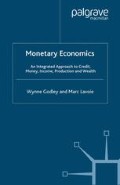Abstract
During the 60-odd years since the death of Keynes there have existed two, fundamentally different, paradigms for macroeconomic research, each with its own fundamentally different interpretation of Keynes’s work.1 On the one hand there is the mainstream, or neo-classical, paradigm, which is based on the premise that economic activity is exclusively motivated by the aspirations of individual agents. At its heart this paradigm requires a neo-classical production function, which postulates that output is the result of combining labour with capital in such a way that, provided all markets clear, there will be no involuntary unemployment while the national income is distributed optimally and automatically between wages and profits. If markets do not clear because wages or prices are ‘sticky’, the same structure will generate determinate, if sub-optimal, disequilibrium outcomes and, for many economists, it is the possibility of such stickiness that defines Keynesian economics. The key assumption that individual welfare maximization is the universal mainspring is not consistent with the view that firms have an independent existence with distinct motivations, because optimum prices, output and employment are all decided for them by the location of aggregate demand and supply schedules. And as production is instantaneous, while supply is brought into equivalence with demand through the market-clearing process, there is no systemic need and therefore no essential place for loans, credit money or banks. The concept of ‘money’ is indispensable, yet money is an asset to which there is not, in general, a counterpart liability and which often has no accounting relationship to other variables. Mainstream macroeconomic theory is a deductive system which needs no recourse to facts (though it may be ‘calibrated’ with numbers) and lends itself to analytic solutions.
I have found out what economics is; it is the science of confusing stocks with flows.
A verbal statement by Michal Kalecki, circa 1936, as cited by Joan Robinson, in ‘Shedding darkness’, Cambridge Journal of Economics, 6(3), September 1982, 295–6.
Access this chapter
Tax calculation will be finalised at checkout
Purchases are for personal use only
Preview
Unable to display preview. Download preview PDF.
Copyright information
© 2007 Wynne Godley and Marc Lavoie
About this chapter
Cite this chapter
Godley, W., Lavoie, M. (2007). Introduction. In: Monetary Economics. Palgrave Macmillan, London. https://doi.org/10.1057/9780230626546_1
Download citation
DOI: https://doi.org/10.1057/9780230626546_1
Publisher Name: Palgrave Macmillan, London
Print ISBN: 978-1-349-35274-6
Online ISBN: 978-0-230-62654-6
eBook Packages: Palgrave Economics & Finance CollectionEconomics and Finance (R0)

